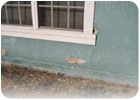
Previously, we reviewed 11 problems that are caused by well-meaning professionals. This month, we will review 20 more. Remember the old cliche, "If a job is worth doing, it is worth doing right."
1. Stucco is over-sanded.
This is a problem that is regularly listed on engineering reports but it is self-curing in that over-sanded stucco is impossible to pump and almost impossible to trowel. That having been said, there is no excuse for using more sand than is specified in the evaluation reports.2. Stucco is under-sanded.
The more under-sanded a stucco is, the creamier it is. Such a stucco is easier to trowel and easier to pump. As the stucco cures, especially if it is not adequately moist cured, the paste shrinks slightly. This can result in map cracking or in weak areas within the stucco that will crack if other stresses are placed on the stucco. This type of cracking looks like the cracks that develop when a puddle of water with clay in it dries.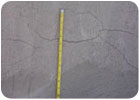
3. Inappropriate gradation of the sand.
There are ASTM and other standards that address the appropriate gradation of sand for stucco. Much sand does not meet these gradations. If used at the recommended concentration, over- or under-sanding problems may become evident. Most but not all, sand can be used if the sand concentration is adjusted. The easiest sands to use are those that are not gap graded and that are rounded. Manufactured sand with angular particles often produces a higher compressive strength but is much more difficult to work with.The evaluation reports specify appropriate gradation. The gradation should not be changed unless an engineering evaluation acceptable to the building officials specifies that changing the gradation and concentration of the sand will not degrade the stucco. The stucco manufacturer is not given the latitude to approve variations in the gradation of the sand.
4. Excess water in the mix.
If the water concentration is slightly high, sagging can occur. There is also a greater likelihood of solution channels in the finished stucco, of plastic shrinkage cracking and other problems that would not otherwise be evident, suddenly showing up.5. Schedule construction to cause movement of the studs before stucco has adequately cured.
The most common manifestation of this problem is attaching interior wallboard after the stucco has been applied. Even using screws rather than nails can cause a problem. Another manifestation is the adding of roofing tile after the stucco has been applied. Heavy winds immediately following stucco application can cause a similar problem but this is not under the control of the general contractor's scheduling. Most evaluation reports mandate that the lath inspection take place after the interior sheathing has been installed but there are contractors who are afraid that the interior sheathing might get wet if correct procedures are followed.6. Adding admixtures that interfere with the chemical integrity of the stucco.
Additives should not be added to most one-coat stuccos but there are applicators who think that they know more than the manufacturers. Adding liquid detergent makes the stucco creamier and lighter to apply but increases the permeability, and reduces the compressive and tensile strengths. Many polymers act as retarders. The list of additives and the damage that they can do is limitless. Nothing but sand and water should be added to a one-coat stucco unless it is authorized by the manufacturer. If anything is added and it has damaged the integrity of the stucco, extensive testing should be done before the stucco is declared acceptable.7. Hard slicking to obtain a smooth wall.
This is an invitation to cracking since hard slicking with a trowel brings the cement fines to the surface. The high paste level produces a surface that has a greater tendency to crack if there are stresses on the wall. This procedure also tends to seal the surface so water cannot migrate through the stucco. The interior of the stucco remains moist, while the surface dries and shrinks and cracks. These are shallow cracks but they are epicenters for further cracking from other causes. A better procedure is to trowel the surface smooth, back drag with the trowel and then lightly slick the surface. Some plasterers refer to this as opening up the plaster so it can breathe. The less sand used in a mix, the more important this procedure becomes.8. Saving money by score joints rather than using control joints.
In three-coat stucco application, the scoring of the stucco, rather than the installation of control joints, has been a common practice for many years. It has no place in one-coat stucco practice.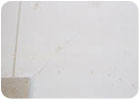
9. Failure to moist cure stucco.
Most evaluation reports mandate 48 hours of moist cure for one-coat stucco. Few one-coat stuccos are cured in this manner. As a result, the stucco may physically dehydrate prior to chemical hydration occurring. This is more likely to occur if conditions are hot, dry or windy. Applying stucco on the sunny side of a building and direct application to an absorbent surface (concrete block) will also bring about rapid dehydration. The formula that is utilized by the stucco manufacturer impacts the tendency of stucco to retain moisture during the curing process. Other things being equal, the higher the reported water retention, the greater the resistance to dehydration.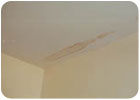
10. Applying stucco when freezing temperatures are forecast.
When cement-based products freeze during the hydration process, the hydration process stops. Part but not all of the stoppage is a result of the effective dehydration of the stucco. Stucco that has been frozen is usually described as soft, delaminated or powdery. Usually, 24 hours of cure is adequate to prevent damage from freezing temperature. If the stucco is only soft or powdery, the possibility exists that the hydration process can be restarted if the wall is kept damp for seven days. To prevent freeze damage of stucco, it should not be applied when the temperature is less than 40 degrees or when freezing temperatures are anticipated within 24 hours. Draping walls and using heaters can safely keep the stucco above freezing temperatures but care needs to be exercised that the stucco is not damaged by the dry air or the carbon dioxide produced by the heater.11. Applying texture coat before basecoat has cured.
Most one-coat stuccos reach a compressive strength of between 2,000 psi and 3,000 psi in 28 days. If a texture coat is applied to a one-coat stucco that has cured for 24 hours and if the texture coat is a high Portland cement texture, the texture may have a greater compressive strength in 24 hours than the one-coat has in 48 hours. If the texture coat shrinks because it is under-sanded (common), it can cause the one-coat stucco to crack. This problem can be eliminated by using the one-coat stucco for making the texture coat or by allowing the one-coat wall to develop strength before texturing.12. Saving money on the sealant system.
Some sealants react with other components of the building envelope. Care should be taken to ensure that the sealants do not react with other components.In residential construction, there are those who believe that $0.79-per-tube caulk applied by an untrained person constitutes waterproofing. It does not. A sealant joint is an area where considerable movement is anticipated. If a sealant joint is made without a bond break on the back of the joint (backer rod), the sealant joint will start to self-destruct when movement occurs. Always use backer rod when using a sealant in any exterior application.
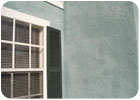
13. Using paint to bridge the cracks in the stucco.
Paints are not and never have been effective at bridging cracks. Paints are applied approximately 2 to 4 mils thick and provide protection only if they are applied to a smooth surface. Hairline cracks are about 1/64 to 1/32 inch in width. That is 16 to 31 mils. The paint coating is too thin to bridge a gap that is eight to 16 times wider than it is thick. That is like pouring a 4-inch sidewalk over a 32- to 64-inch trench without any forming to hold the concrete in place until it cures.Elastomeric coatings are not paints but are often confused with paints. Elastomeric coatings should not be expected to bridge cracks over 3/32 of an inch in width. If cracks are over 3/32 of an inch in width, they should be filled prior to painting. Even this statement is questionable since a Sherwin Williams representative recently told me that if the crack can be seen, it should be filled prior to coating with elastomeric coating.
14. Using paint to waterproof the stucco wall.
Paints are not designed to keep water out of a wall. They are designed to provide a uniform color. Careful examination of a textured stucco wall that has been painted will reveal many areas, especially below texture chips, that have not been coated with a minimum of 2 mils thickness. Cracks, conduits for water to flow through the stucco, have not been bridged by the paint. Stucco is not-and never has been-considered to be waterproof. The minimum weather-resistive barrier, as is commonly applied, is usually substantially compromised. Paint does not provide waterproofing.Elastomeric coatings are designed to keep water from passing through a stucco wall. Most are described as water-resistant rather than waterproof. Most one-coat manufacturers recommend that elastomeric coatings be used to protect the stucco. Elastomeric coatings should be applied from 8 to 24 mils in thickness. Different manufacturers have different recommendations. Seldom can a water-resistant finish be developed with a single coat of elastomeric coating. When applying a coating, a common technique is to spray the elastomeric onto the surface and while still wet, back roll. Other techniques recommended by the coating manufacturer are also effective. A technique must be used that ensures that all parts of the stucco wall come in intimate contact with the first coating of elastomeric. The second coat should be applied in a manner that ensures that the second coat comes in intimate contact with the first coat.
If stucco cracks after it has been painted, the crack will also extend through the paint. This is the nature of paint. If stucco coated with an elastomeric paint cracks, the crack may remain covered or it may cause the elastomeric coating to crack. The thinner the elastomeric coating-other things being equal-the more likely the coating will crack. Most good elastomerics have a 250 percent or greater elasticity. This sounds like a great deal but if the elastomeric is firmly bonded at two points that are 1/64 inch apart and the crack opens to 3/64 inch, then the elastomeric at the stucco surface will be stretched 300 percent. A stucco building should not be painted or coated with elastomeric until the movement of the building has settled down. Neither paint nor elastomeric coatings should be considered structural elements of the building.
15. Using a non-vapor-permeable paint or coating to waterproof a building.
If paint or elastomeric coating is non-vapor-permeable, it may blister, peel and lead to a build-up of water in the wall, which can lead to mold problems. Blistering of paint is the result of a vapor seal, poor bonding to the substrate and water vaporizing within the wall. The peeling of paint or a coating often occurs after the coating has blistered and the blisters have broken. Only vapor-permeable paints and coatings should be used on stucco. Early elastomeric coatings were not vapor-permeable. There are still some on the market that are not vapor-permeable.16. Rushing the application of paint or elastomeric coating.
A period of 28 days is required for the surface pH of some stucco to reach 9.0 to 9.5. Many paints and elastomeric coatings do not form strong bonds at elevated pHs. Coatings have been changing during the past few years and there are now some coatings that will provide a good bond at higher pHs. If paint or a coating is to be applied before 28 days of cure, the pH of the wall should be tested to ensure it has dropped to a safe level or an acceptable "quick cure" sealer should be applied to the stucco. The paint or coating manufacturer determines the acceptability of the "quick cure," not the stucco manufacturer.Poor bonding can result in the paint or coating peeling, blistering or coming off in one piece. Problems in an otherwise pristine building may show up after a wall has been subjected to a negative wind load or after a penetration has been cut into a wall.
An additional problem with early application of paint or a coating is that calcium hydroxide moving to the surface can cause calcium carbonate to form on the surface. This results in permanent efflorescence on the coating. Acid washing is required to remove it.
17. A slightly dirty wall was not cleaned before paint or elastomeric coating was applied.
Paint and elastomeric coatings will adhere to the dirt. This reduces the bond between the paint or coating and the stucco. Problems of peeling and blistering that otherwise might not show up are more likely to appear.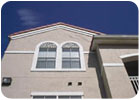
18. To provide a smoother surface for the paint or coating, the stucco was sand finished.
Sand finishing involves the rubbing of the surface of the stucco with a wet sponge near the time of the initial set. In the process, sand is brought to the surface and cement particles are removed from the stucco. Additionally, the water/cement ratio on the surface of the stucco is increased. When this is done to one-coat stucco, the water/cement ratio of most of the stucco layer is increased. This results in a surface that is softer than is usually observed with one-coat stucco. While this technique has been successful on many occasions, the bond of the paint or coating to the stucco that is keyed into the lath is reduced. As a result, the paint or coating may separate from the stucco.Often, the low bond problem is not evident until a wall is subjected to a negative wind load or a penetration is cut into the wall. Since the coating is thicker on three-coat stucco applications, it does not cause as many problems. If a sand finish must be used, take care to use the minimum amount of water possible.
19. Cracks were repaired by caulking or by covering with glass tape and then finished.
Both of these methods can repair cracks but there is a change in the texture of the stucco and in certain lighting conditions the repairs remain very evident. The best method is to design and construct the building so cracks do not occur. Failing that, a light skim coat before texturing will fill cracks and allow for finishing over them. Another method is filling the cracks with an elastomeric crack filler (thicker than an elastomeric coating-do not trowel the crack filler 4 inches on each side of a crack), followed by painting on an elastomeric crack bridging coating and feathering it. The wall can then be finished with an elastomeric coating and the patch will tend to blend in with the rest of the wall.20. The exterior of the building was not inspected at least once per year.
If a problem develops, early detection can often prevent extensive damage. Normal building maintenance by the building owner should include inspections of all sealant joints at least once per year and also a walk around the building to determine whether any changes have occurred in the building exterior.One-coat stucco, when applied correctly, is one of the least expensive and most durable wall treatments available. If "creative profit-generating technology" is used, severe problems can develop. Do not hesitate to use one-coat stucco; just use it as it was designed to be used.
If you have seen cases of failure for one-coat stucco because of actions taken by well meaning professionals, let us know so we can pass the word and educate everyone, from applicators to architects.
If you read this article, please circle number 325.

Report Abusive Comment